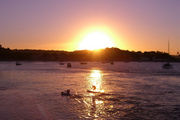
Itacare
Encyclopedia

Bahia
Bahia is one of the 26 states of Brazil, and is located in the northeastern part of the country on the Atlantic coast. It is the fourth most populous Brazilian state after São Paulo, Minas Gerais and Rio de Janeiro, and the fifth-largest in size...
in Brazil
Brazil
Brazil , officially the Federative Republic of Brazil , is the largest country in South America. It is the world's fifth largest country, both by geographical area and by population with over 192 million people...
, south of Salvador. It is located 70 km north of Ilhéus
Ilhéus
Ilhéus is a major city located in the southern coastal region of Bahia, Brazil, 430 km south of Salvador, the state's capital. The city was originally founded in 1534 as Vila de São Jorge dos Ilhéus and is known as one of the most important tourism centers of the northeast of Brazil.The...
where the Rio de Contas
Rio de Contas
Rio de Contas is a municipality in the Bahia state, in the eastern part of Brazil. Its estimated population in was 13,710.Rio de Contas has its origins in the 18th century. In 1718 the town of "Santo Antônio de Mato Grosso" was founded...
, which comes from the Chapada Diamantina
Chapada Diamantina
Chapada Diamantina is a region of Bahia state, in the Northeast of Brazil.The Chapada Diamantina has a dramatic landscape with high plains, table-top mesas, and steep cliffs or towers known as 'tepuy.' Before the arrival of the Portuguese in the 19th century, the only local inhabitants of the...
, meets the Atlantic Ocean
Atlantic Ocean
The Atlantic Ocean is the second-largest of the world's oceanic divisions. With a total area of about , it covers approximately 20% of the Earth's surface and about 26% of its water surface area...
. It has a population of approximately 8,000.
Itacaré was founded as a Portuguese colonial settlement, originally called São Jorge dos Ilhéus, in 1532. The town was a notorious hangout for Dutch and Portuguese pirates during the early colonial period and later became a hub for the cocoa planting and a port for whalers. It was officially given city status in 1881.
After a massive blight of Vassoura de Bruxa
Witch's broom
A Witch's broom is a disease or deformity in a woody plant, typically a tree, where the natural structure of the plant is changed. A dense mass of shoots grows from a single point, with the resulting structure resembling a broom or a bird's nest....
(Witch's broom) devastated the region's cocoa crops in the 1980s, Itacaré has depended mostly upon tourism. It is a popular destination for surfers, hikers and ecotourists.
The town has a series of beautiful small cove type beaches and other picturesque beaches further along the coast. Itacaré is on the edge of a national park, one of the last large expanses of Atlantic rain forest left in Brazil.
The change from sleepy agrarian town to tourist hotspot has not been an easy one, however. Locals recently won a hard-fought campaign to stop land owners who wanted to charge for access to the beaches.
Access to one of the most pristine beaches, Prainha, has been blocked by a hotel/condominium development called Sao Jose Eco Resort. Both Prainha and Sao Jose beaches are now accessible by foot., free of charge.
Despite development in the area, it remains a hub of Bahian culture. Many tourists visit Itacaré to take part in the local Capoeira
Capoeira
Capoeira is a Brazilian art form that combines elements of martial arts, sports, and music. It was created in Brazil mainly by descendants of African slaves with Brazilian native influences, probably beginning in the 16th century...
circles and eat traditional Brazilian food. The town is flooded with revelers during New Year's and Carnival
Brazilian Carnival
The Carnival of Brazil is an annual festival held forty-six days before Easter. On certain days of Lent, Roman Catholics and some other Christians traditionally abstained from the consumption of meat and poultry, hence the term "carnival," from carnelevare, "to remove meat." Carnival celebrations...
.

